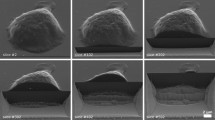Abstract
Contamination of the food chain by mercury is a major concern of Public Health of our day. Kidney and nervous system are the major targets of mercury toxicity in mammals. We show here that the detailed subcellular in vivo topography of microparticles of mercury in tissues can be achieved by scanning electron microscopy (SEM) coupled with X-ray elemental microanalysis (XRM). SEM-XRM offered the fine topography of mercury in the kidney of BALB/c mice that were submitted to an intraperitoneal lethal injection of mercuric chloride (HgCl2). All of the renal mercury was seen inside blood vessels located in both cortex and medulla of the mouse kidney. This blood-born mercury was organised in spheroid particles of less than 50 nm in diameter (31.4±14.1 nm). They were seen attached either to aggregates of plasma proteins or to the surface of blood cells. No evidence of internalisation of mercury by blood, endothelial or kidney cells was found. The average kidney density of mercury microspheres was 1920±1320 particles per mmsup b2b sup. We propose SEM-XRM as an elective approach to further investigations, at the subcellular level, on the quantitative dynamics of mercury particles in the tissues.
Similar content being viewed by others
References
Carrington CD, Bolger MP. 2002 An exposure assessment for methylmercury from seafood for consumers in the United States. Risk Anal 22, 689–699.
Clarkson TW. 2002 The three modern aces of mercury. Environ Health Perspect 110, 11–23.
Falnoga M, Tuek-nidari M, Horvat M, Stegnar P. 2000 Mercury, selenium, and cadmium in human autopsy samples from Idrija residents and mercury mine workers. Environ Res 3, 211–218.
FDA 1999 Action level for mercury on fish, shellfish, crustaceans, and other aquatic animals. Federal Register 44, 3990–3993.
Formanek R Jr. 2001 Highlights of FDA food safety efforts: fruit juice, mercury in fish. FDA Consum 35, 15–17.
Garnier R, Riboulet-Delmas G, Chabaux C, Efthymiou ML, Kholi M, Fournier E. 1982 Subcutaneous injection of metallic mercury. Toxicol Eur Res 4, 197–200.
Ginsberg GL, Toal BF, 2000 Development of a single-meal fish consumption advisory for methyl mercury. Risk Anal 20, 41–47.
Goering PL, Fisher BR, Noren BT, Papaconstantinou A, Rojko JL, Marler RJ. 2000 Mercury induces regional and cell-specific stress protein expression in rat kidney. Toxicol Sci 53, 447–457.
Goldman LR, Shannon MW. 2001 Mercury in the environment: Implications for pediatricians. Pediatr 108, 197–205.
Guallar E, Sanz-Gallardo I, Veer P, Bode P, Aro A, Gomes-Aracena J, Kark JD, Riemersma RA, Martin-Moreno JM, Kok FJ. 2002 Mercury, fish oils, and risk of myocardial infarction. N Engl J Med 347, 1745–1756.
Lupton GP, Kao GF, Johnson FB, Graham JH, Helwig EB. 1985 Cutaneous mercury granuloma. A clinicopathologic study and review of the literature. J Am Acad Dermatol 12, 296–303.
Moller-Madsen B. 1994 Localization of mercury in CNS of the rat. An autometallographic study. Pharmacol & Toxicol 75, 1–41.
Myers GJ, Davidson PW, Cox C, Shamlaye C, Cernichiari E, Clarkson TW. 2000 Twenty-seven years studying the human neurotoxicity of methylmercury exposure. Environ Res 83, 275–285.
Nadarajah V, Neiders ME, Aguirre A, Cohen RE. 1996 Localized cellular inflammatory responses to subcutaneous implanted dental mercury. J Toxicol Environ Health 49, 113–125.
Netscher DT, Friedland JA, Guzewicz RM. 1991 Mercury poisoning from intravenous injection: treatment by granuloma resection. Ann Plast Surg 26, 592–596.
Nordberg M, Trojanowska B, Nordberg GF. 1974 Studies on metalbinding proteins of low molecular weight from tissue of rabbits exposed to cadmium or mercury. Environ Physiol Biochem 4, 149–158.
Peão MDN, Águas AP, Sá CM, Grande NR. 1993 Inflammatory response of the lung to tungsten particles: na experimental study in mice submitted to intracheal instillation of a calcium tungstate powder. Lung 171, 187–201.
Pless R, Risher JF. 2000 Mercury, infant neurodevelopment, and vaccination. Pediatr 136, 571–573.
Rumbeiha WK, Fitzgerald SD, Braselton WE, Roth RA, Pestka JJ, Kaneene JB. 2000 Augmentation of mercury-induced nephrotoxicity by endotoxin in the mouse. Toxicology 151, 103–116.
Sau P, Solivan G, Johnson FB. 1991 Cutaneous reaction from a broken thermometer. J Am Acad Dermatol 25, 915–919.
Silva MT, Appelberg R, Silva MNT, Macedo PM. 1987 In vivo killing and degradation of Mycobacterium aurum within mouse peritoneal macrophags. Infect Immunity 55, 2006–2116.
Schionning JD, Eide R, Moller-Madsen B, Ernst E. 1993 Detection of mercury in rat spinal cord and dorsal root ganglia after exposure to mercury vapor. Exp & Mol Pathol 25, 215–228.
Schionning JD, Danscher G, Christensen MM, Ernst E, Moller-Madsen B. 1993 Differentiation of silver-enhanced mercury and gold in tissue sections of rat dorsal root ganglia. Histochem 25, 107–111.
Timbrel JA. 1982 Biochemical mechanisms of toxicity: specific examples. Principles of Biochemical Toxicology. Taylor & Francis Ltd., London.
Timbrel JA. 1989 Environmental Pollutants: Mercury and Methylmercury. Introduction to Toxicology. Taylor & Francis Ltd., London.
Watts J. 1997 Minamata Bay finally declared free of mercury. Lancet 350, 422.
Yoshizawa K, Rimm EB, Morris JS, Spate VL, Hsieh CC, Spiegelman D, Stampfer MJ, Willett WC. 2002 Mercury and the risk of coronary disease in men. N Engl J Med 347, 1755–1760.
Zalups RK. 2000 Molecular interactions with mercury in the kidney Pharmacol Rev 52, 113–143.
Author information
Authors and Affiliations
Rights and permissions
About this article
Cite this article
Cunha, E.M., Silva, D.P. & Águas, A.P. High-resolution identification of mercury in particles in mouse kidney after acute lethal exposure – A study by Scanning Electron Microscopy coupled with X-ray Elemental Microanalysis. Biometals 16, 583–590 (2003). https://doi.org/10.1023/A:1023451407164
Issue Date:
DOI: https://doi.org/10.1023/A:1023451407164




